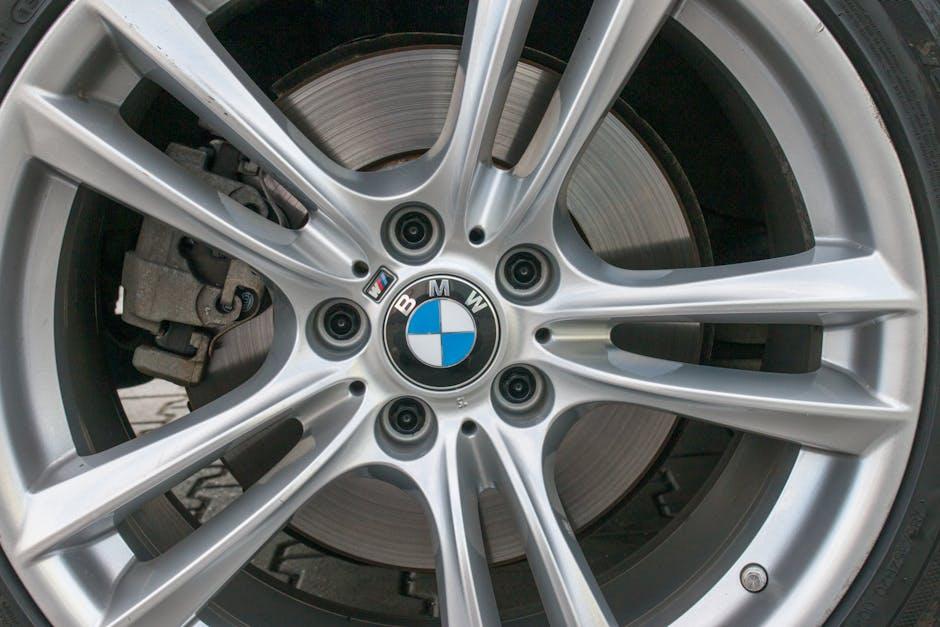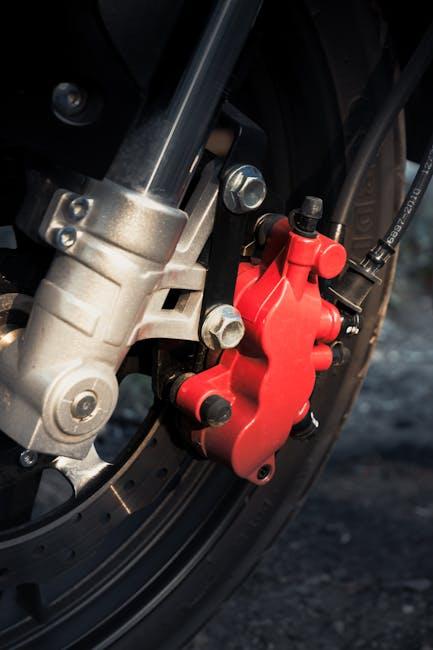When was the last time you gave your brakes a genuine moment of attention? Much like the unsung heroes of a car’s safety system, brake pads and rotors quietly endure countless stops, starts, and sudden halts. Over time, these crucial components inevitably wear down, signaling that it’s time for attention or replacement. Recognizing the subtle—and sometimes not so subtle—signs of worn brake pads and rotors can mean the difference between a smooth, safe ride and unexpected trouble on the road. In this article, we’ll explore how to spot these warning signals early, helping you maintain control and confidence every time you press the pedal.
Table of Contents
- Understanding the Critical Role of Brake Pads and Rotors
- Common Audible Warnings Indicating Brake Wear
- Visual Clues That Signal Pad and Rotor Deterioration
- How Brake Performance Changes with Wear
- Safety Risks Associated with Ignoring Brake Symptoms
- Practical Tips for Timely Inspection and Replacement
- Q&A
- In Retrospect

Understanding the Critical Role of Brake Pads and Rotors
Brake pads and rotors work in perfect tandem to ensure your vehicle stops safely and smoothly every time you press the brake pedal. The brake pads create the necessary friction against the rotors, which slows down the wheel’s rotation and brings the car to a halt. Over time, both components endure significant wear and tear, and neglecting their condition can lead to reduced braking efficiency or even dangerous situations on the road. Understanding the importance of these parts helps you recognize early warning signs and prioritize maintenance before minor issues turn into costly repairs.
Both brake pads and rotors show common symptoms when worn, but their effects differ. You might notice:
- Unusual noises: Squealing or grinding sounds often indicate thinning brake pads or damaged rotors.
- Vibrations: Pulsation in the brake pedal usually suggests warped rotors requiring resurfacing or replacement.
- Extended stopping distances: Worn pads decrease friction efficiency, demanding longer distances to stop safely.
- Visual inspection cues: Thin pads or grooves on rotors can be seen upon checking, signaling the need for urgent attention.
| Symptom | Likely Component | Recommended Action |
|---|---|---|
| Squealing Sound | Brake Pads | Inspect & Replace Pads |
| Grinding Noise | Rotors & Pads | Full Brake System Check |
| Brake Pedal Vibration | Warped Rotors | Rotor Resurfacing/Replacement |
| Longer Stopping Distance | Worn Pads | Brake Pad Replacement |

Common Audible Warnings Indicating Brake Wear
When your vehicle starts to emit unusual sounds during braking, it’s often a clear cry for attention from your brake system. The most frequently heard warning is a sharp squealing or squeaking noise, caused by a built-in wear indicator rubbing against the rotor. This sound serves as an early alert that brake pads have worn down close to their minimum thickness. Another common auditory signal is a grinding noise, which is far more serious and indicates that metal-to-metal contact is occurring due to severely worn pads or damaged rotors. Ignoring these sounds could lead to costly repairs or compromised safety.
Drivers might also notice a distinct chirping or high-pitched whistle first thing in the morning or after driving through moisture, which can indicate glazing or a buildup of brake dust. Occasionally, a clunking or rattling noise when braking can point to loose or broken components within the brake system. To better understand these audible cues, here’s a concise guide:
| Sound | Likely Cause | Urgency |
|---|---|---|
| Squealing | Worn brake pad indicator | Moderate |
| Grinding | Metal-to-metal contact | High |
| Chirping | Glazing or brake dust buildup | Low |
| Clunking | Loose components | Moderate |

Visual Clues That Signal Pad and Rotor Deterioration
When brake pads and rotors begin to show signs of wear, keen observers can often spot visual indicators before performance worsens. Cracks or grooves on the rotor surface are classic warning signs that the metal is under stress and losing its smoothness, which negatively affects braking efficiency. Additionally, pads that appear thin, unevenly worn, or with visible metal strips suggest it’s time for replacement. You might also notice a bluish tint on the rotors, a subtle but telling sign of overheating, which can lead to warping and vibrations during braking.
Keep an eye out for these visual cues to avoid unexpected brake failure:
- Deep scoring or scratches on the rotor face
- Uneven pad wear indicating possible caliper issues
- Corrosion or rust buildup around the rotor edges
- Pad material thinner than 3mm or almost metal-to-metal contact
| Visual Clue | What It Indicates | Potential Consequence |
|---|---|---|
| Grooves on Rotor | Rotor surface damage | Reduced braking smoothness |
| Thin Brake Pad | Worn pad material | Decreased stopping power |
| Bluish Rotor Tinge | Overheating | Rotor warping |

How Brake Performance Changes with Wear
As brake pads and rotors gradually wear down, their ability to effectively slow your vehicle diminishes, leading to increased stopping distances and lower braking responsiveness. This decline isn’t always immediately noticeable but manifests through subtle changes such as a softer brake pedal or a faint vibration during braking. The friction surface becomes thinner, generating less grip and heat dissipation, which can cause your brakes to feel mushy or even less consistent over time.
Several factors contribute to the altered brake performance as wear progresses, including increased rotor runout and uneven pad thickness. Below is a simple comparison showcasing common symptoms associated with early wear versus advanced wear:
| Wear Stage | Brake Feel | Common Symptoms |
|---|---|---|
| Early Wear | Firm but gradually softening |
|
| Advanced Wear | Spongy or unresponsive |
|

Safety Risks Associated with Ignoring Brake Symptoms
Ignoring warning signs from your brake system can transform a manageable repair into a dangerous and costly ordeal. When brake pads and rotors become excessively worn, your vehicle’s stopping power diminishes dramatically, increasing the risk of accidents. Failing to address squealing noises, vibrations, or extended stopping distances can lead to brake failure, jeopardizing not only your safety but also that of passengers and other road users. It’s crucial to recognize these signals early to prevent sudden brake malfunctions that can cause dangerous situations, especially in high-traffic or emergency braking scenarios.
Beyond the immediate threat of collisions, worn brake components contribute to uneven wear and tear on related systems, leading to further mechanical issues. Below is a concise overview of the potential safety hazards linked to disregarding critical brake symptoms:
- Reduced braking efficiency: Increased stopping distance under normal and emergency conditions.
- Brake fade: Temporary loss of brake power after repeated use, especially on downhill slopes.
- Unstable vehicle control: Pulling to one side or vibrations during braking can cause loss of steering control.
- Complete brake failure: In extreme cases, worn pads may expose metal, resulting in loss of braking capability.
| Symptom | Possible Consequence | Recommended Action |
|---|---|---|
| Squealing or grinding noise | Rotor damage, brake fade | Replace pads immediately |
| Vibrations while braking | Uneven rotor wear | Resurface or replace rotors |
| Longer stopping distances | Reduced brake efficiency | Check brake fluid and pad thickness |
| Brake pedal feels soft | Possible brake fluid leak | Inspect hydraulic system |

Practical Tips for Timely Inspection and Replacement
Keeping your brake system in top shape hinges on regular maintenance and keen observation. Start by visually inspecting the brake pads through the wheel spokes; if the pad thickness is below 3 millimeters, it’s a clear sign to replace them immediately. Pay attention to any unusual sounds like squealing or grinding when applying brakes—these noises often indicate that the pads have worn down to the metal backing. Additionally, a vibration in the brake pedal or steering wheel during braking can suggest warped rotors that need resurfacing or replacement.
To simplify your maintenance routine, use this quick-reference guide for inspection intervals based on typical driving conditions:
| Driving Condition | Inspection Frequency | Replacement Advice |
|---|---|---|
| Urban (stop-and-go traffic) | Every 6,000 miles | Replace pads every 20,000 miles |
| Highway Cruising | Every 12,000 miles | Replace pads every 30,000 miles |
| Mountainous/Towing | Every 5,000 miles | Replace pads every 15,000 miles |
- Monitor brake responsiveness—if stopping distance increases, inspect immediately.
- Schedule professional checks during oil changes or tire rotations.
- Keep brake fluid fresh—old fluid reduces braking efficiency.
Q&A
Q: How can I tell if my brake pads are wearing out?
A: One of the clearest signs is a high-pitched squealing noise when you press the brake pedal. This sound comes from a built-in wear indicator designed to alert you that the pads are running thin. Additionally, if your braking distance increases or the pedal feels less responsive, it’s time to inspect those pads.
Q: What are the visual clues that my brake pads or rotors need attention?
A: You can often see the brake pads through the wheel spokes. If the pad lining looks less than a quarter-inch thick, they’re likely due for replacement. For rotors, look for deep grooves, cracks, or uneven wear patterns. A shiny or bluish tint on the rotor surface may also indicate overheating.
Q: Can I feel worn brake pads or rotors while driving?
A: Absolutely. Pulsations or vibrations in the brake pedal or steering wheel when applying brakes often suggest warped rotors. Squeaking, grinding noises, or a rough braking sensation also point toward worn pads or damaged rotors needing prompt service.
Q: Is it safe to ignore these signs for a while?
A: Ignoring warning signs is risky. Worn brake pads and rotors reduce braking efficiency, increasing stopping distances and the chance of accidents. You may also damage other braking components, leading to costlier repairs down the line.
Q: How often should I check my brake system for wear?
A: It’s a good practice to have your brakes inspected during every oil change or every 6,000 to 10,000 miles. However, if you notice any symptoms like noise, vibrations, or diminished brake performance, get them checked sooner.
Q: Can I replace brake pads and rotors myself?
A: If you have mechanical skills and proper tools, DIY replacement is possible, but brakes are a critical safety component. For peace of mind and proper installation, many prefer having a certified technician handle the job.
Q: What happens if only the pads are worn but the rotors look fine?
A: Replacing just the brake pads can often restore braking performance if the rotors are still in good shape. However, if rotors show wear signs such as warping or grooves, resurfacing or replacement may be necessary alongside the pads.
Q: Do brake pads and rotors wear out at the same rate?
A: Not necessarily. Pads usually wear faster as they directly press against the rotors to create friction. Rotors generally last longer but can suffer from damage or warping due to heat and stress, necessitating separate replacement intervals.
This Q&A provides a well-rounded understanding of how to identify and respond to signs of worn brake pads and rotors, helping drivers maintain safety and optimal vehicle performance.
In Retrospect
Recognizing the signs of worn brake pads and rotors isn’t just about maintaining your vehicle—it’s about safeguarding every journey you take. From subtle squeaks to pulsating pedals, these warning signals are your car’s way of saying it’s time for attention. By staying alert and addressing wear early, you ensure not only smoother rides but also peace of mind on every road ahead. After all, when it comes to brakes, staying proactive is the best way to keep your drive safe and sound.


2 Comments
tr6tqj
tr6tqj